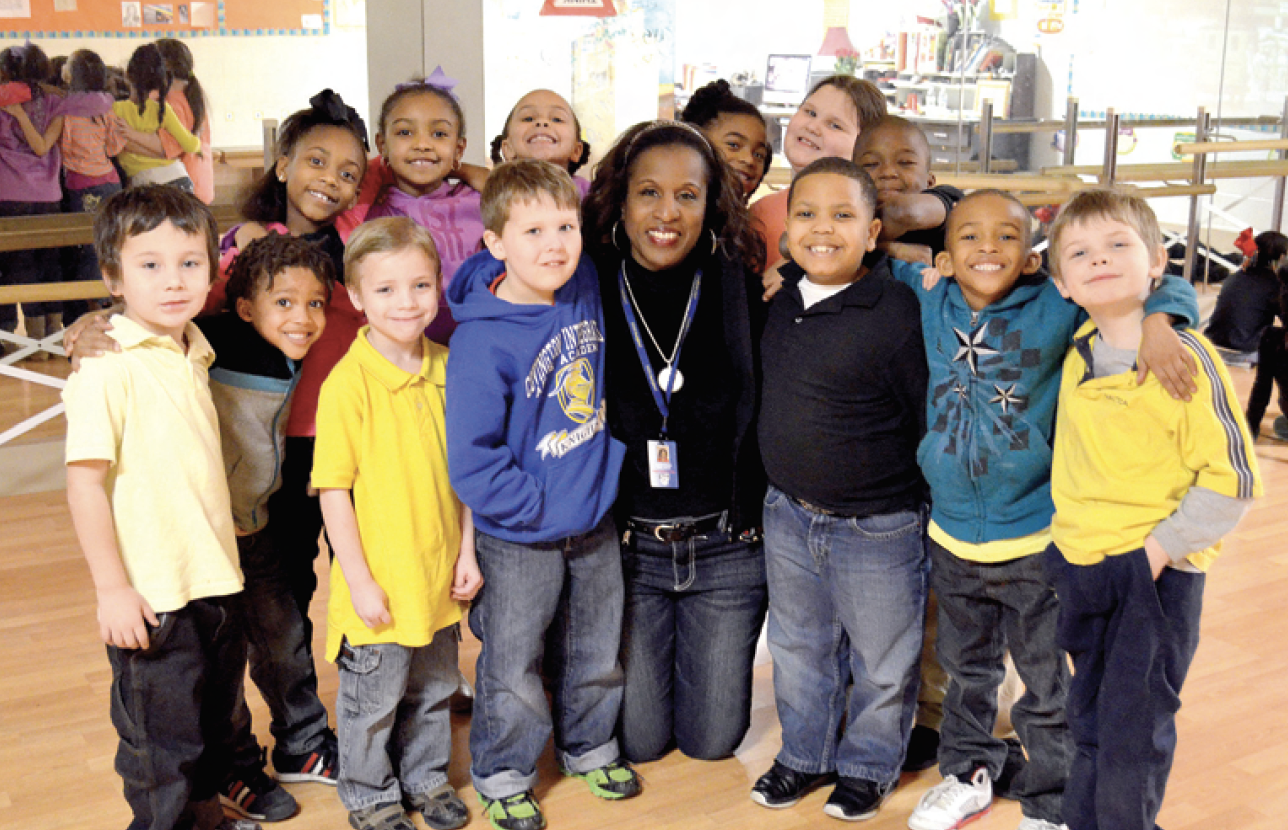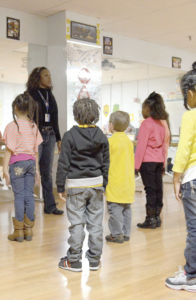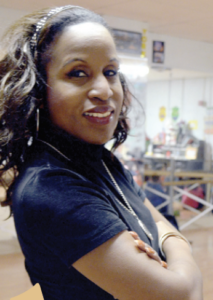

A line of children is formed in the hall outside Deborah Walker’s room, students waiting patiently as older dancers straggle behind from the previous class. Twenty-nine youngsters fill into the dance studio and at once the open space turns into a crowded room. The fourth graders take second position and begin warming up with isolations.
Led by four dance captains, today’s lesson will cover lyrical choreography and connecting poetry and dance, especially when poetry is used in conjunction with rhythm.
Deborah Walker, drama and dance teacher, moves around the floor, monitoring the students. She stops for a moment, and shows proper alignment and then continues counting out the beats.
“Everything in dance goes back to ballet, whether jazz, hip hop or whatever,” proclaims Walker, continuing to talk through the new dance routine.
“In, out, kick, step, turn, down on gluteus, out, out cross legs, get ready to push up….good,” she encourages.

The suspended floor has a slight give to it, so that young dancers’ bodies are cushioned during movement. Ballet barres grace the floor to ceiling mirrored wall, as the students face front and learn the dance they’ve just been given.
The dance captains, who are seventh and eighth graders, teach the dance phrases to the younger children, having learned from Walker in their master class. They lead the class with confidence, which in itself is a testament to their teacher. These are the children who are a part of Walker’s select dance and drama team, and who have daily class with her.
The younger children, the class, only come to Walker’s classroom one hour each week and therefore must make the best use of their time.
Walker, a teacher at Covington Integrated Arts Academy, where fine art influences and is incorporated into each core subject, uses a broad understanding of connectivity to add language arts into her classes. She is mindful that, even in dance, once can work towards studying for the Tennessee Comprehensive Assessment Program, or TCAP.
She had been on the dance squad in high school, but it wasn’t until college that she became seriously interested. Walker credits the moment, the turning point, to a performance her sister took her to at the Orpheum starring Alexander Godunov and Mikhail Baryshnikov.
 Her criminal justice undergraduate degree is from the University of Memphis doesn’t speak to her future, but her minor in dance, does. After college, she worked in her sister’s shop, while raising her family.
Her criminal justice undergraduate degree is from the University of Memphis doesn’t speak to her future, but her minor in dance, does. After college, she worked in her sister’s shop, while raising her family.
As she credits her love of dance to her sister, she credits her teaching drama and dance to her daughter.
“My daughter was a cheerleader, and when she was in the fourth grade, she told her coach that her mother could dance and would teach them a routine. I started teaching the cheerleaders and continued with the routines even after my daughter had graduated. The principal, Charlesetta Brown, asked me to start subbing, so I did, full time, and I worked with the kids. She said I had a gift, that I was good with kids, and that I need to go back and get a masters in education. She and my daughter were my motivations for pursing a career in teaching.
Walker has a masters of education and psychology from Cambridge College, an educational specialist degree, and is a certified dance teacher. She also is on the Tennessee Arts Commission artist roster, as a grant funded dance instructor who shows other schools how to integrate dance and drama into their core curriculum.
Today’s dance class involves writing poetry to use with rhythm and movement. The children excitedly break into three groups of 10 each, noisily developing poems, to perform with dance and musicians. After several minutes, one group is chosen to go first, while the other two groups form an audience and view.
Each group has assigned a rapper, who speaks the poem, articulately and with volume; dancers, to help create fluidity with the piece; and musicians, providing music through consistent beats.
“Cheetahs run fast, they have a lot of mass, they cost a lot of cash,” recites the young girl in the first group.
“Good, but slow it down,” says Walker.
The young poet says it again, while the assigned dancers sway back and forth to the pounding feet of the musicians.
A quick discussion of the difference between poetry and rap ensues.
Walker watches with a developed eye, silently grading through movement, understanding and participation in the performance. She’s developed a rubric and grades 10-1, with 10 being an A+.
At the end, Ms. Walker critiques the three distinct styles of performances. “That was very good, but do we think anyone made a 10 today?” she asks, appraisingly.
The children agree: not today.
The energy in the room is palpable and the focus is steady and unwavering. The only side conversations are those of dance and the room’s activities and even those are scarce.
Too soon, is time for this class to leave, as the bell has just rung and there are only five minutes between classes. The students say goodbye and scoot out of the studio.
Walker waves them goodbye, until next week, breathes deeply and smiles as she turns to face a new line of 20 students that has already formed in the hallway, waiting. Waiting to enter this magical room of dance and dreams, where imagination will ensue.






Leave a Reply